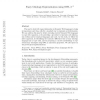Free Online Productivity Tools
i2Speak
i2Symbol
i2OCR
iTex2Img
iWeb2Print
iWeb2Shot
i2Type
iPdf2Split
iPdf2Merge
i2Bopomofo
i2Arabic
i2Style
i2Image
i2PDF
iLatex2Rtf
Sci2ools
CORR
2010
Springer
2010
Springer
Fuzzy Ontology Representation using OWL 2
The need to deal with vague information in Semantic Web languages is rising in importance and, thus, calls for a standard way to represent such information. We may address this issue by either extending current Semantic Web languages to cope with vagueness, or by providing a procedure to represent such information within current standard languages and tools. In this work, we follow the latter approach, by identifying the syntactic differences that a fuzzy ontology language has to cope with, and by proposing a concrete methodology to represent fuzzy ontologies using OWL 2 annotation properties. We also report on the prototypical implementations. Key words: Fuzzy OWL 2, Fuzzy Ontologies, Fuzzy Languages for the Semantic Web, Fuzzy Description Logics
| Added | 09 Dec 2010 |
| Updated | 09 Dec 2010 |
| Type | Journal |
| Year | 2010 |
| Where | CORR |
| Authors | Fernando Bobillo, Umberto Straccia |
Comments (0)

